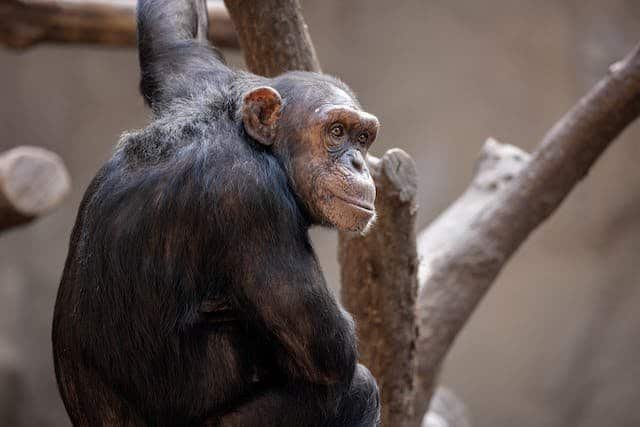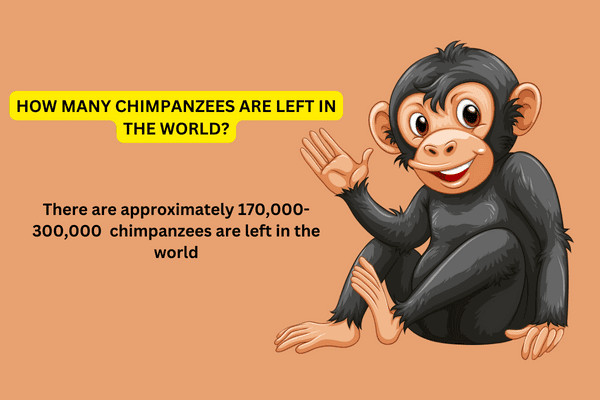Have you ever wonder that How Many Chimpanzees Are Left In The World? Chimpanzees, also known as just chimps, are highly social animals that live in groups with dozens of other chimpanzees, known as communities. These communities are led by an alpha male, who is supported by a group of other males. Belonging to the great ape species, chimpanzees are very closely related to humans, sharing 98.7% of our DNA.
Chimpanzees are one of our closest living relatives. They live in tropical forests in 21 countries across Africa. Unfortunately, due to deforestation, poaching, and disease, their numbers have significantly decreased in recent years.
Table of Contents
Types Of Chimpanzees
The IUCN Red List of Threatened Species lists chimpanzees as endangered, meaning they face a very high risk of extinction in the wild. There are two subspecies of chimpanzees; the Western Chimpanzee and the Eastern Chimpanzee. The Western Chimpanzee is listed as critically endangered, with only around 35,000 individuals remaining in the wild. The Eastern Chimpanzee has a slightly larger population of around 115,000 individuals but is still considered endangered.
Where Do Chimpanzees Live?
Chimpanzees have the widest geographic distribution of any great ape species, spanning more than 2.6 million square kilometres. The chimpanzee habitat is typically found within tropical rainforests, although they do also live in woodlands and grasslands around West and Central Africa.
You’ll often find chimps up trees, either sleeping in nests of leaves or eating.
Are Chimpanzees Endangered?

Yes, both subspecies of chimpanzees are endangered and their populations continue to decline. The main threats facing chimpanzees include habitat loss and degradation, hunting for bushmeat, and capture for the illegal pet trade. Climate change is also becoming a more significant threat as it impacts the availability of food and water.
Historical Population Trends Of Chimpanzees
Here are given below the historical population of Chimpanzees:
1.How Many Chimpanzees Were There About 25-40 Millions Ago?
It is difficult to estimate the exact number of chimpanzees that existed about 25-40 millions ago as there was no proper data collection or conservation efforts at that time. However, it is believed that their population was significantly higher than what it is today.
2.How Many Chimpanzees Were There In 1960?
In 1960, an estimated 1 million chimpanzees were living in the wild. This number has drastically decreased over the years due to human activities and habitat loss.
3.How Many Chimpanzees Were There In 1980?
The population of chimpanzees in 1980 was estimated to be around 500,000 individuals. Half their population from just two decades before had already disappeared.
4.How Many Chimpanzees Are Left In The World In 20th Century?
In the 20th century, there were an estimated one million chimpanzees living in the wild. However, due to habitat destruction and hunting, their numbers have decreased by at least 66% in the past 40 years. In some areas, such as Gombe National Park in Tanzania, chimpanzee populations have declined by up to 90%.
As of 2020, it is estimated that there are less than 300,000 chimpanzees left in the wild. This number may seem large, but compared to their population just a few decades ago, it is a drastic decline.
How Many Chimps Are Killed?
It’s estimated that up to 3,000 chimpanzees are taken from the wild every year. But that doesn’t account for the numerous animals (usually mature adults) killed in the wake of this illegal trade, or potentially butchered for bushmeat. These numbers are exacerbated by the chimpanzee’s slow reproductive rate.
Who Hunts Chimpanzees The Most?

Chimpanzees are hunted and killed by humans for a variety of reasons, including the bushmeat trade, traditional medicine, and as pets. In some cultures, chimpanzee meat is considered a delicacy or a source of power. However, the majority of poaching for bushmeat is conducted by commercial hunters who sell the meat to urban markets.
Is Chimpanzees Were Killed By Any Animal?
Although chimpanzees are apex predators, they do have natural predators such as leopards and humans. Lions and leopards are known predators of chimpanzees [38–41], although in the absence of direct evidence scavenging cannot always be ruled out [42]. However, human activities pose a much greater threat to their survival than other animals in their ecosystem.
What Is The Main Cause Of Death For Chimpanzees?
The main cause of death for chimpanzees is human activity. This includes habitat destruction through deforestation and logging, hunting for bushmeat, and the illegal pet trade. Diseases : Chimpanzees share 98.4% of their DNA with humans, making them very susceptible to human diseases. Their habitat’s destruction and the expansion of human settlements greatly increase their risk of contracting human diseases. Diseases such as Ebola also play a major role in their declining population.
Role Of Chimpanzees In Their Ecosystem
Chimpanzees play a crucial role in their ecosystems as seed dispersers and by maintaining forest health. Their decline not only puts their species at risk but also has a significant impact on the balance of their habitats.
Which Country Has The Highest Number Of Chimpanzees?

The Democratic Republic of Congo has the highest number of chimpanzees, with an estimated 150,000 individuals living in its forests. Other countries with significant populations include Gabon, Cameroon, and Central African Republic.
What Is The Conservation Efforts For Chimpanzees?
Conservation efforts are being made to protect chimpanzees and their habitats, but more needs to be done. Illegal wildlife trade and habitat destruction continue to be major threats to their survival. It is important for governments, organizations, and individuals to take action in order to ensure the survival of these incredible animals. The number is alarming and continues to decrease each year.
How Can We Help Chimpanzees?
We can help chimpanzees by supporting conservation efforts and organizations that work towards protecting their habitats and preventing illegal wildlife trade. We can also make conscious decisions in our daily lives, such as avoiding products that contribute to the destruction of rainforests where chimpanzees live. Additionally, we can educate ourselves and others about the importance of chimpanzee conservation and spread awareness through social media and other platforms. Together, we can make a difference and help save the remaining chimpanzee populations in the world.
Final Thoughts
Chimpanzees are an iconic and incredible species that play a crucial role in their ecosystems. However, their populations continue to decline due to human activities. It is important for us to take action now and protect these animals before it’s too late. With conservation efforts and responsible behaviors, we can ensure the survival of our closest living relatives on this planet.
Read Also: What Are The Arabian Horses Used For?





